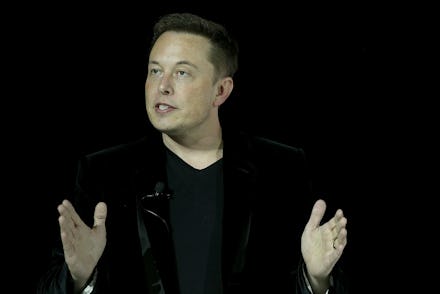3 reasons why you shouldn’t have fallen for Elon Musk’s hyperloop plans

Elon Musk, the futurist tycoon behind Tesla autonomous vehicles and SpaceX rocket launches, tweeted out a vague and somewhat misguided claim last week. Only July 21, Musk said that he had “verbal government approval” to build his visionary hyperloop tunnel between four major U.S. cities — New York City, Philadelphia, Baltimore and Washington. Imagine an underground sled that lifts and carries cars at a goal speed of 700 mph through a tube.
The internet exploded with reports announcing the so-called approval, but Musk later followed up with a less-exciting detail: “Still a lot of work needed to receive formal approval,” he tweeted, “but [I] am optimistic that will occur rapidly.” By that point, he already had the world’s attention.
The excitement is understandable. Upgrading from a three-hour train ride between New York and Washington to a high-speed tunnel that takes us there in under 30 minutes would definitely be dreamy. But there are a few rings Musk has to jump through first.
1. This isn’t an executive decision
After Musk tweeted that he got verbal approval, a White House Spokesman told the Washington Post that Musk and the Trump Administration “have had promising conversations to date.” That’s not the same thing as having a green light.
Even if Musk really did get “verbal approval” from President Trump himself, it would be just one of the many sign-offs required before his boring machine can tear up dirt across state lines.
“Any large-scale transit project like this requires coordination and collaboration with transportation officials on the local and state level,” Brooks Rainwater, director of the Center for City Solutions in Washington, said by phone. “What you can gather is that there wasn’t that level of communication.”
According to Rainwater, the list of involved parties is a long one: “state-level oversight, local oversight, collaboration between the local, state and federal government, environmental planning routines,” he said. Plus, there could conceivably be opposition from people affected by the hyperloop’s construction. We won’t know until a real proposal is on the table.
2. We don’t know who’s going to pay for it
The U.S. doesn’t exactly have a track record (get it?) for laying down new railways or massive transportation infrastructure at a low cost. Extending Los Angeles’ subway routes, for example, is at least a $1.4 billion project — and transportation officials recently asked for funds to increase to $1.7 billion last January, which is 28% more than the original budget.
Though a hyperloop may be a different beast than a traditional subway route, governments would still need to figure out how they’re going to pay for it.
“Certainly, doing the hyperloop underground would be incredibly costly,” Rainwater said. “Particularly a route from NY to D.C. The land acquisition to build something like this would be very high.”
3. The technology itself might not be ready
Though Musk and engineers have claimed that the hyperloop would take passengers from one city to another at a goal of 700 mph, we haven’t actually seen proof that it really works as advertised.
“We just need to see the hyperloop work as it’s been constructed to actually show that it can, in fact, take people at that level of speed,” Rainwater said.
Musk posted a video on his official Instagram account earlier this year showing a test run for an “electric sled” that could allegedly move cars through tunnels at 125 mph, but that’s a solid 575 mph less than what’s promised.
Musk has long seemed optimistic about the tech behind a possible future hyperloop.
“It’s really not that hard,” he said in a 2015 video interview with CNN Money. “It’s like a tube with an air hockey table. It’s just a low-pressure tube with a pod in it that runs on air bearings, on air skis.”
Regardless, this whole plan is a multi-step process from start to finish — one that may not happen as “rapidly” as Musk promised in his tweet. Musk’s hyperloop will have to navigate safety tests, bureaucracy, construction and more.
“It really just depends, you know,” Rainwater said. “The timeline will shorten significantly when we see the hyperloop proven. That’s when we’ll see local and federal governments really moving forward … But once that happens, you still have the whole planning process, which often times takes years.”